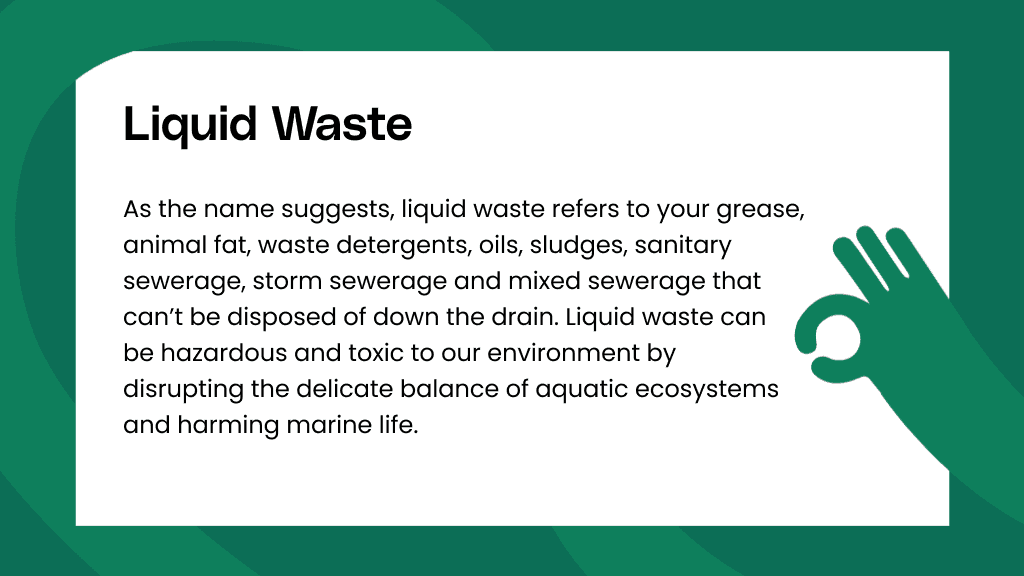The Best Guide To Reclaim Waste
Table of ContentsThe Ultimate Guide To Reclaim WasteThe Main Principles Of Reclaim Waste Rumored Buzz on Reclaim WasteOur Reclaim Waste StatementsHow Reclaim Waste can Save You Time, Stress, and Money.
Domestic sewer waste refers to the waste and products from a property septic container. The correct management and disposal of domestic sewer waste call for liquid waste to be moved to a sewage therapy plant where the proper approaches and equipment are used to cleanse and dispose of waste.
Commercial waste commonly includes prospective hazards, such as combustible materials or a mixture of liquid and strong waste products, and requires a much more advanced and thorough disposal process. The disposal of business waste normally entails the filtering of waste prior to transportation to guarantee secure and appropriate disposal. Hazardous waste is developed from byproducts and drainage of commercial procedures and production.
This type of waste can not make use of the same sewage monitoring transport or procedures as septic or business fluids. The hazardous waste monitoring procedure needs the inspection and testing of liquid waste prior to it undertakes the disposal procedure (liquid waste removal melbourne). Runoff waste is the liquid waste that comes from overflow and excess stormwater in very booming locations or cities
Runoff waste can trigger contamination and flooding if not dealt with properly. Find out more about drain cleaning and waste administration. Making certain proper waste management can avoid disasters and reduce environmental injury. Both people in household setups and specialists in industrial or manufacturing markets can take advantage of understanding the procedures and laws of liquid waste administration.
3 Easy Facts About Reclaim Waste Explained
Call PROS Solutions today to discover our waste administration and disposal services and the appropriate means to take care of the fluid waste you produce.
(https://giphy.com/channel/reclaimwaste1)This supposed 'wastewater' is not just an important source but, after treatment, will certainly be launched to our land, rivers or the sea. Utilized water from toilets, showers, baths, kitchen sinks, laundries and industrial procedures is recognized as wastewater.

water used to cool equipment or tidy plant and devices). Stormwater, a type of wastewater, is runoff that moves from agricultural and urban areas such as roofings, parks, gardens, roads, paths and gutters into stormwater drains pipes, after rain. Stormwater streams unattended directly to neighborhood creeks or rivers, ultimately getting to the sea.
Some Known Incorrect Statements About Reclaim Waste
In Queensland, most wastewater is dealt with at sewage therapy plants. Wastewater is carried from residential or industrial websites via a system of sewage systems and pump terminals, referred to as sewage reticulation, to a sewer therapy plant. City governments develop, keep and operate most sewage treatment plants. Operators are certified under the Environmental Defense Act 1994 to release cured wastewater at an appropriate environmental requirement into waterways.
The Department of Natural Resources encourages local federal governments about managing, operating and maintaining sewage systems and therapy plants. In unsewered locations, city governments might need householders to mount specific or family sewage therapy systems to deal with residential wastewater from toilets, cooking areas, restrooms and laundries. The Division of Natural Resources authorizes the usage of family systems when they are verified to be effective.
A lot of stormwater gets no treatment. In some new neighborhoods, treatment of some stormwater to get rid of trash, sand and gravel has actually begun using gross toxin traps. Wastewater therapy happens in 4 phases: Eliminates strong matter. Larger solids, such as plastics and various other items mistakenly released to sewers, are gotten rid of when wastewater is passed through screens.
Wastewater after that moves into big tanks where solids clear up and are removed as sludge. Grease and scum are skimmed from the surface. Makes use of tiny living microorganisms referred to as micro-organisms to break down and remove continuing to be dissolved wastes and great fragments. Micro-organisms and wastes are incorporated in the sludge. Removes nitrogen and phosphorus nutrients that might trigger algal blooms in our waterways and intimidate aquatic life.
Things about Reclaim Waste
Nutrient removal is not available in any way sewer treatment plants due to the fact that it calls for expensive specialist devices. It is coming to be more common in Queensland. Clear liquid effluent produced after treatment may still consist of disease-causing micro-organisms. If this effluent is released into waterways such as rivers or the sea, the micro-organisms will ultimately die out.

This usually means wastewater has actually to be dealt with or contaminants removed prior to it can be released to rivers. Most wastewater flows right into the sewerage system. Under the Act, local governments carry out approvals and permits for environmentally relevant activities (Periods) including wastewater launches that may have a local impact. The division provides authorizations and licences to ERAs entailing wastewater releases that may have a local or statewide impact.
Reclaim Waste Fundamentals Explained
Or else, samples are taken for laboratory analysis. Frequently lots of examinations are needed to develop the degrees of each of the various contaminants such as oils, hefty steels and pesticides in water. Monitoring gives factual info about water quality and can verify that permit conditions are being fulfilled. The information obtained through tracking supplies the basis for making water top quality choices.